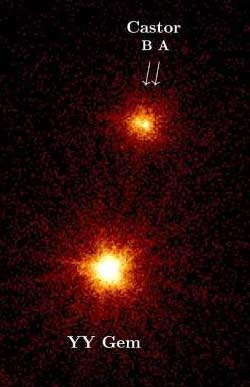XMM-Newton image of Castor & YY Gem
Behind the apparently simple brightness of certain stars there is often a fascinating complexity. That is the case for the particularly interesting Castor stellar system upon which XMM-Newton has shed new light. Castor is the second brightest star in the Gemini constellation (The Twins) after Pollux. Its magnitude as seen by the naked eye is 1.6. But this brightness is the combined result of not one but six stars, in three pairs, all waltzing around each other. This sextuplet consists first of a pair of A-type stars, orbiting each other with a period of 467 years. They are just observable with an amateur optical telescope with a separation of only 3.9 arcseconds. Slightly to the south of this pair is the M-type dwarf star YY Gem which has long attracted astronomers for its frequent flare outbursts. (Spectral type-A stars have surface temperatures respectively in the range 7,500-11,000 Kelvin and are white in colour. M-type stars are cooler, with surface temperatures between 2,400-3,480 Kelvin and are red in colour.) But to complicate matters, each of these three stars is a binary system by itself with very intriguing and different properties. The brighter of the A-stars is accompanied by an invisible dwarf in a highly eccentric orbit. The other A-star hosts a similar companion but in a circular orbit. YY Gem, finally, is made up of two identical M-dwarfs that orbit each other in only 19 hours. As we look at this system from the side, every 9.5 hours one of the dwarfs is almost completely eclipsed by its companion. High-resolution jpeg
IMAGES |
By Mission |
Stars |
HEASARC Home | Observatories | Archive | Calibration | Software | Tools | Students/Teachers/Public Last modified: Thursday, 26-Jun-2003 13:48:45 EDT HEASARC Staff Scientist Position - Applications are now being accepted for a Staff Scientist with significant experience and interest in the technical aspects of astrophysics research, to work in the High Energy Astrophysics Science Archive Research Center (HEASARC) at NASA Goddard Space Flight Center (GSFC) in Greenbelt, MD. Refer to the AAS Job register for full details. |


